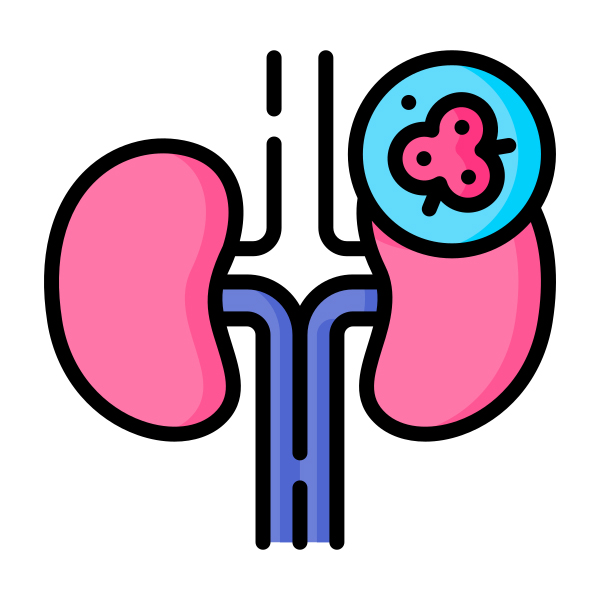Chronic kidney disease (CKD), also known as chronic renal disease, is a five-stage progressive loss of renal function that occurs over months or years. Each stage represents a progression through an abnormally low and deteriorating glomerular filtration rate, which is usually determined indirectly by the level of creatinine in blood serum.
Stage 1 CKD is characterised by mildly impaired renal function and few visible symptoms.
Stage 5 CKD is a severe disease that necessitates some form of renal replacement therapy (dialysis or renal transplant). End-stage renal disease (ESRD), chronic kidney failure (CKF), or chronic renal failure are all terms used to describe stage 5 CKD (CRF).
Chronic kidney disease signs and symptoms
Initially, there are no symptoms and only an increase in serum creatinine or protein in the urine can be detected. As kidney function declines:
- Because of fluid overload and the production of vasoactive hormones, blood pressure rises, increasing the risk of developing hypertension and/or suffering from congestive heart failure.
- Urea builds up, causing azotemia and, eventually, uremia (symptoms ranging from lethargy to pericarditis and encephalopathy). Sweating excretes urea, which crystallises on the skin (“uremic frost”).
- Potassium builds up in the blood (known as hyperkalemia with a range of symptoms including malaise and potentially fatal cardiac arrhythmias)
- The synthesis of erythropoietin is reduced (potentially leading to anaemia, which causes fatigue)
- Fluid volume overload – symptoms range from mild edema to potentially fatal pulmonary edema.
- Hyperphosphatemia is caused by decreased phosphate excretion and is associated with hypocalcemia (due to vitamin D3 deficiency).
- Later, this progresses to tertiary hyperparathyroidism, which is characterised by hypercalcaemia, renal osteodystrophy, and vascular calcification, all of which impair cardiac function.
- Metabolic acidosis is caused by the accumulation of sulphates, phosphates, uric acid, and other waste products. This may result in altered enzyme activity due to excess acid acting on enzymes, as well as increased excitability of cardiac and neuronal membranes due to hyperkalemia caused by excess acid (acidemia).
Chronic kidney disease patients have accelerated atherosclerosis and are more likely than the general population to develop cardiovascular disease. Patients who have chronic kidney disease and cardiovascular disease have significantly worse prognoses than those who only have the latter.
Chronic kidney disease diagnosis
Many CKD patients have a history of renal disease or other underlying diseases. A small percentage of patients present with CKD of unknown aetiology. In these patients, a cause is occasionally discovered after the fact.
It is critical to distinguish CKD from acute renal failure (ARF) because ARF can be reversed. Abdominal ultrasound is a common procedure for measuring the size of the kidneys. A gradual rise in serum creatinine (over several months or years), as opposed to a sudden rise in serum creatinine, is another diagnostic clue that helps differentiate CKD and ARF (several days to weeks). If these levels are unavailable (because the patient has been well and no blood tests have been performed), it is occasionally necessary to treat a patient as having ARF for a short period of time until it is determined that the renal impairment is irreversible.
Causes of Chronic kidney disease
Diabetic nephropathy, hypertension, and glomerulonephritis are the most common causes of CKD. These three factors account for roughly 75% of all adult cases. HIV nephropathy is more common in certain geographic areas.
Historically, kidney disease has been classified based on the part of the renal anatomy involved, as follows:
- Vascular disease includes both large and small vessel disease, such as bilateral renal artery stenosis and ischemic nephropathy, hemolytic-uremic syndrome, and vasculitis.
- The glomerular disease includes a wide range of conditions and is further subdivided into Primary Glomerular diseases, such as focal segmental glomerulosclerosis and IgA nephritis.
- Diabetic nephropathy and lupus nephritis are examples of secondary glomerular disease.
- Polycystic kidney disease, drug and toxin-induced chronic tubulointerstitial nephritis, and reflux nephropathy are all examples of tubulointerstitial nephritis.
- Obstructive conditions, such as bilateral kidney stones and diseases of the prostate
Homoeopathy Treatment for Chronic kidney disease Homoeopathy looks at the whole person. This means that homoeopathic treatment focuses on both the patient as a person and his pathological condition. Homoeopathic medicines are chosen after a thorough individualising examination and case analysis, which includes the patient’s medical history, physical and mental constitution, family history, presenting symptoms, underlying pathology, potential causative factors, and so on. A miasmatic tendency (predisposition/susceptibility) is frequently considered in the treatment of chronic conditions. A homoeopathic doctor attempts to treat more than just the symptoms that are present. Typically, the focus is on what caused the disease condition.

